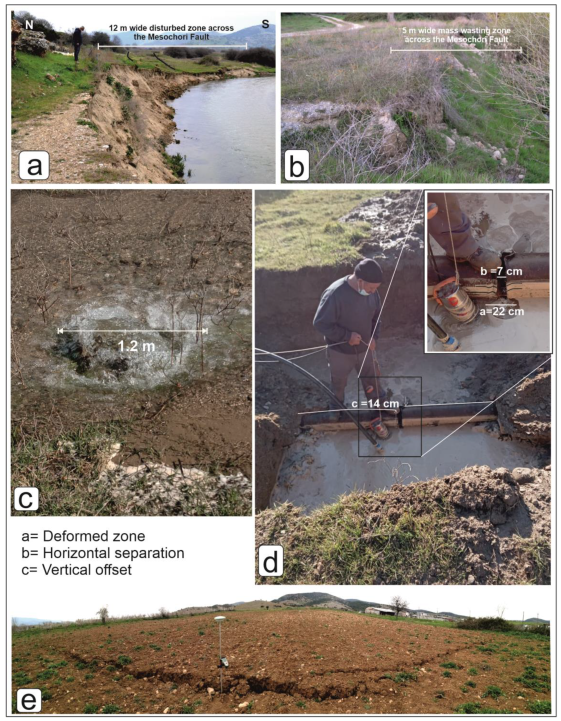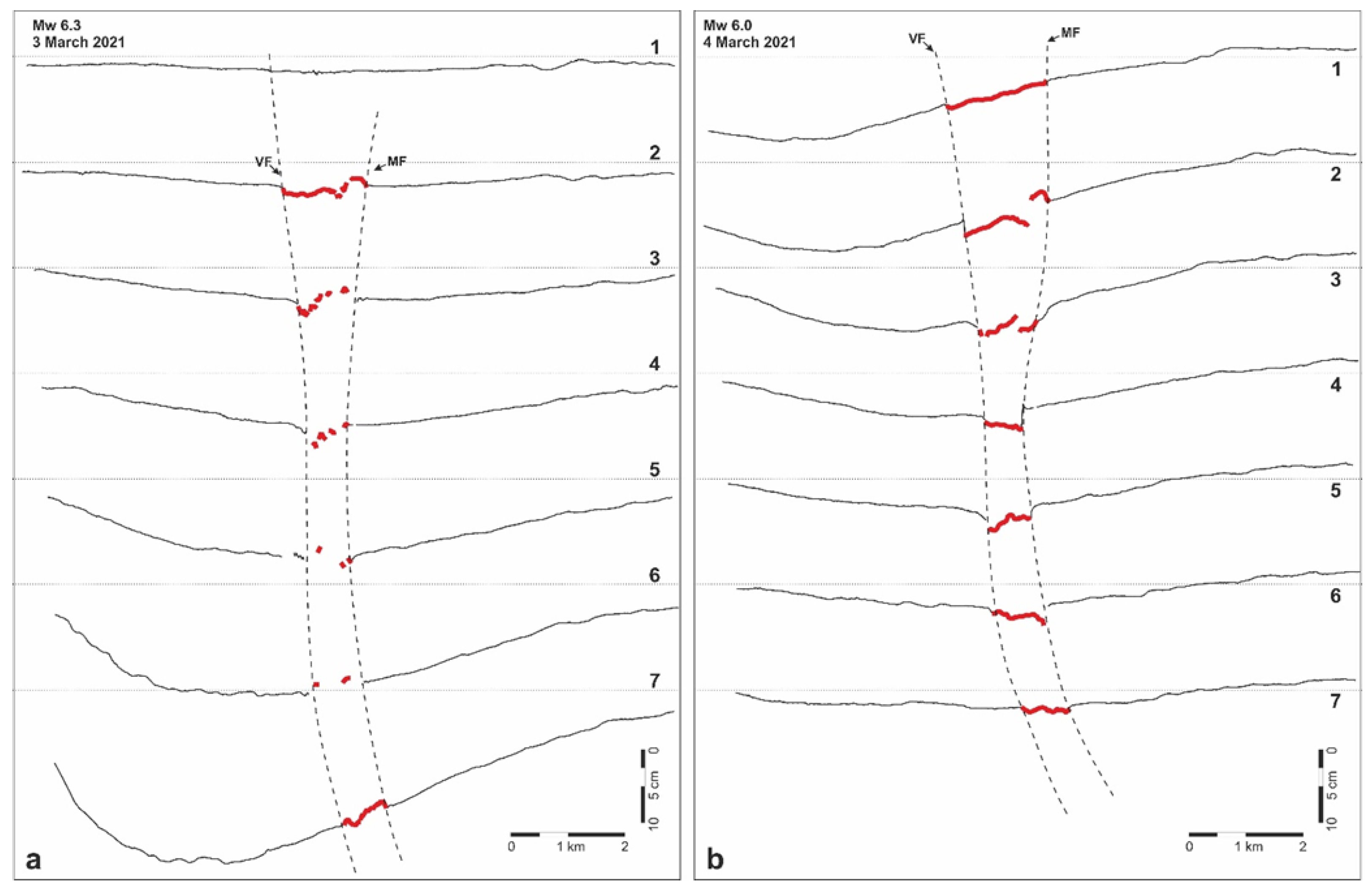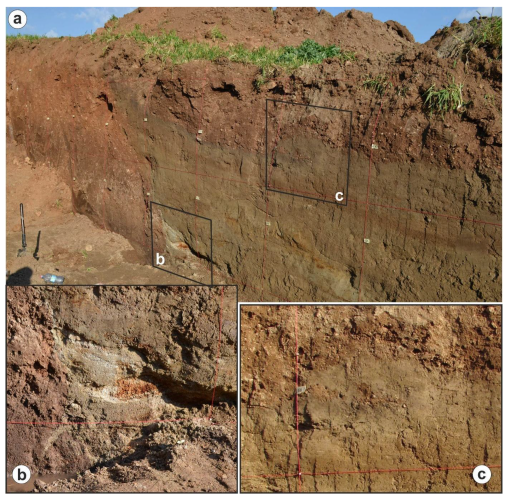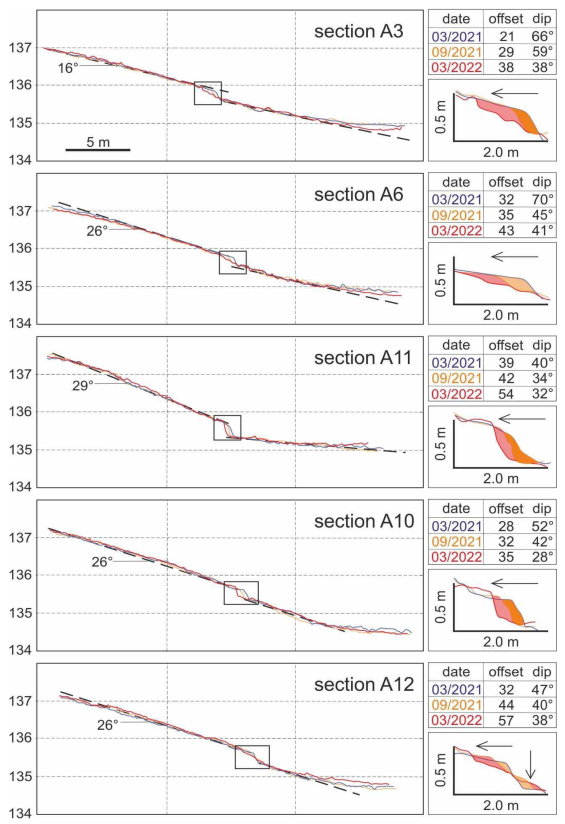Is the Mesochori Fault a Key Structure for Understanding the Earthquake Activity during the 2021 Damasi Earthquakes in Northern Thessaly, Greece?
Abstract
:1. Introduction
| Date | Time | Lat (°) | Long (°) | Depth | Mw | Strike | Dip | Rake |
|---|---|---|---|---|---|---|---|---|
| 3 March 2021 | 10:16:08.58 | 39.7349 | 22.1908 | 9.5 | 6.3 | 314 | 36 | −88 |
| 3 March 2021 | 11:45:45.70 | 39.6909 | 22.2025 | 8.29 | 5.2 | 310 | 47 | −74 |
| 3 March 2021 | 18:24:08.72 | 39.7225 | 22.0813 | 10 | 5.1 | 319 | 38 | −62 |
| 4 March 2021 | 18:38:17.46 | 39.7799 | 22.1252 | 12 | 6.0 | 329 | 41 | −88 |
| 4 March 2021 | 19:23:51.18 | 39.8224 | 21.9313 | 7.86 | 5.1 | 287 | 30 | −91 |
| 12 March 2021 | 12:57:50.14 | 39.8281 | 22.0150 | 3.34 | 5.5 | 286 | 53 | −92 |
2. Materials and Methods
2.1. The Titarisios River Graben (TRG)
2.2. Coseismic Evidence along the TRG: Field Observations
2.3. Coseismic Evidence along the TRG: DInSAR Results
3. Palaeoseismology across the Mesochori Fault
4. Postseismic Activity along the TRG
5. Conclusions
Supplementary Materials
Author Contributions
Funding
Data Availability Statement
Acknowledgments
Conflicts of Interest
References
- Caputo, R. Inference of a seismic gap from geological data: Thessaly (Central Greece) as a case study. Ann. Geofisica 1995, 38, 1–19. [Google Scholar] [CrossRef]
- Caputo, R. Morphotectonics and kinematics along the Tyrnavos Fault, northern Larissa Plain, mainland Greece. In Neotectonics and Active Faulting; Stewart, I., Vita-Finzi, C., Owen, L.A., Eds.; Borntraeger: Stuttgart, Germany, 1993; Volume 94, pp. 167–185. [Google Scholar]
- Caputo, R.; Piscitelli, S.; Oliveto, A.; Rizzo, E.; Lapenna, V. The use of electrical resistivity tomographies in active tectonics: Examples from the Tyrnavos Basin, Greece. J. Geodyn. 2003, 36, 19–35. [Google Scholar] [CrossRef]
- Caputo, R.; Helly, B.; Pavlides, S.; Papadopoulos, G. Palaeoseismological investigation of the Tyrnavos Fault (Thessaly, Central Greece). Tectonophysics 2004, 394, 1–20. [Google Scholar] [CrossRef]
- Caputo, R. The Rodia Fault: An active complex shear zone (Larissa Basin, Central Greece). Bull. Geol. Soc. G. 1993, 18, 447–456. [Google Scholar]
- Caputo, R.; Pavlides, S. Late Cainozoic geodynamic evolution of Thessaly and surroundings (Central-Northern Greece). Tectonophysics 1993, 223, 339–362. [Google Scholar] [CrossRef]
- Caputo, R.; Helly, B. The Holocene activity of the Rodia Fault, Central Greece. J. Geodyn. 2005, 40, 153–169. [Google Scholar] [CrossRef]
- Caputo, R.; Pavlides, S. The Greek Database of Seismogenic Sources (GreDaSS), Version 2.0.0: A Compilation of Potential Seismogenic Sources (Mw > 5.5) in the Aegean Region. 2013. Available online: http://gredass.unife.it/ (accessed on 30 July 2023). [CrossRef]
- Tolomei, C.; Caputo, R.; Polcari, M.; Famiglietti, N.A.; Maggini, M.; Stramondo, S. The use of Interferometric Synthetic Aperture Radar for isolating the contribution of major shocks: The case of the March 2021 Thessaly, Greece, seismic sequence. Geosciences 2021, 11, 191. [Google Scholar] [CrossRef]
- De Novellis, V.; Reale, D.; Adinolfi, G.M.; Sansosti, E.; Convetito, V. Geodetic Model of the March 2021 Thessaly Seismic Sequence Inferred from Seismological and InSAR Data. Remote Sens. 2021, 13, 341. [Google Scholar] [CrossRef]
- Ganas, A.; Valkaniotis, S.; Briole, P.; Serpetsidaki, A.; Kapetanidis, V.; Karasante, I.; Kassaras, I.; Papathanassiou, G.; Karamitros, I.; Tsironi, V.; et al. Domino-style earthquakes along blind normal faults in Northern Thessaly (Greece): Kinematic evidence from field observations, seismology, SAR interferometry and GNSS. Bull. Geol. Soc. G. 2021, 58, 37–86. [Google Scholar] [CrossRef]
- Papadopoulos, G.A.; Agalos, A.; Karavias, A.; Triantafyllou, I.; Parcharidis, I.; Lekkas, E. Seismic and Geodetic Imaging (DInSAR) Investigation of the March 2021 Strong Earthquake Sequence in Thessaly, Central Greece. Geosciences 2021, 11, 311. [Google Scholar] [CrossRef]
- Kassaras, I.; Kapetanidis, V.; Ganas, A.; Karakostantis, A.; Papadimitriou, P.; Kaviris, G.; Kouskouna, V.; Voulgaris, N. Seismotectonic analysis of the 2021 Damasi-Tyrnavos (Thessaly, Central Greece) earthquake sequence and implications on the stress field rotations. J. Geodyn. 2022, 150, 101898. [Google Scholar] [CrossRef]
- Karakostas, V.; Papazachos, C.; Papadimitriou, E.; Foumelis, M.; Kiratzi, A.; Pikridas, C.; Kostoglou, A.; Kkallas, C.; Chatzis, N.; Bitharis, S.; et al. The March 2021 Tyrnavos, central Greece, doublet (Μw6.3 and Mw6.0): Aftershock relocation, faulting details, coseismic slip and deformation. Bull. Geol. Soc. Greece 2021, 58, 131–178. [Google Scholar] [CrossRef]
- Valkaniotis, S.; Papathanassiou, G.; Ganas, A.; Kremastas, E.; Caputo, R. Preliminary Report of Liquefaction Phenomena Triggered by the March 2021 Earthquakes in Central Thessaly, Greece. Available online: https://zenodo.org/record/4608365#.YFD0mp1KhhE (accessed on 20 August 2023).
- Lekkas, E.; Agorastos, K.; Mavroulis, S.; Kranis, C.; Skourtsos, E.; Carydis, P.; Gogou, M.; Katsetsiadou, K.-N.; Papadopoulos, G.; Triantafyllou, I.; et al. The early March 2021 Thessaly Earthquake Sequence. Newsl. Environ. Disaster Crises Manag. Strateg. 2021, 22. [Google Scholar] [CrossRef]
- Pavlides, S.; Caputo, R. Magnitude versus faults’ surface parameters: Quantitative relationships from the Aegean Region. Tectonophysics 2004, 380, 159–188. [Google Scholar] [CrossRef]
- Caputo, R. Ground effects of large morphogenic earthquakes. J. Geodyn. 2005, 40, 113–118. [Google Scholar] [CrossRef]
- Papathanassiou, G.; Valkaniotis, S.; Ganas, A.; Stampolidis, A.; Rapti, D.; Caputo, R. Floodplain evolution and its influence on liquefaction clustering: The case study of March 2021 Thessaly, Greece, seismic sequence. Eng. Geol. 2022, 298, 106542. [Google Scholar] [CrossRef]
- Koukouvelas, I.K.; Nikolopoulos, K.G.; Kyriou, A.; Caputo, R.; Mpelesis, A.; Zygouri, V.; Verroios, S.; Apostolopoulos, D.; Tsentzos, I. The March 2021 Damasi earthquake sequence, Central Greece: Reactivation evidence across the westward propagating Tyrnavos Graben. Geosciences 2021, 11, 328. [Google Scholar] [CrossRef]
- Doutsos, T.; Pe-Piper, G.; Boronkay, K.T.; Koukouvelas, I. Kinematics of the central Hellenides. Tectonics 1993, 12, 936–953. [Google Scholar] [CrossRef]
- Caputo, R.; Helly, B. Archaeological evidences of past earthquakes: A contribution to the SHA of Thessaly, Central Greece. J. Earthq. Eng. 2005, 9, 199–222. [Google Scholar] [CrossRef]
- McCalpin, J.P. (Ed.) Paleoseismology; Academic Press: San Diego, CA, USA, 1996; p. 588. [Google Scholar]
- Koukouvelas, I.K.; Zygouri, V.; Papadopoulos, G.A.; Verroios, S. Holocene record of slip-predictable earthquakes on the Kenchreai Fault, Gulf of Corinth, Greece. J. Struct. Geol. 2017, 94, 258–274. [Google Scholar] [CrossRef]
- Caputo, R. Geological and structural study of the recent and active brittle deformation of the Neogene-Quaternary basins of Thessaly (Central Greece). In Scientific Annals; Aristotle University of Thessaloniki: Thessaloniki, Greece, 1990; p. 255. [Google Scholar]
- Caputo, R.; Helly, B.; Rapti, D.; Valkaniotis, S. Late Quaternary hydrographic evolution in Thessaly (Central Greece): The crucial role of the Piniada Valley. Quat. Int. 2021, 635, 3–19. [Google Scholar] [CrossRef]
- Morley, C.K.; Nelson, R.A.; Patton, T.L.; Munn, S.G. Transfer zones in the East African rift system and their relevance tohydrocarbon exploration in rifts. Bull. Am. Ass. Petrol. Geol. 1990, 74, 1234–1253. [Google Scholar]
- Massonnet, D.; Feigl, K.L. Radar interferometry and its application to changes in the Earth’s surface. Rev. Geophys. 1998, 36, 441–500. [Google Scholar] [CrossRef]
- Goldstein, R.M.; Werner, C.L. Radar interferogram filtering for geophysical applications. Geophys. Res. Letts. 1998, 25, 4035–4038. [Google Scholar] [CrossRef]
- Rosen, P.A.; Hensley, S.; Zebker, H.A.; Webb, F.H.; Fielding, E.J. Surface deformation and coherence measurements of 623 Kilauea Volcano, Hawaii, from SIR-C radar interferometry. J. Geophys. Res. Planets. 1996, 101, 23109–23125. [Google Scholar] [CrossRef]
- Tsodoulos, I.M.; Stamoulis, K.; Caputo, R.; Koukouvelas, I.; Chatzipetros, A.; Pavlides, S.; Gallousi, C.; Papachristodoulou, C.; Ioannides, K. Middle-Late Holocene earthquake history of the Gyrtoni Fault, Central Greece: Insight from optically stimulated luminescence (OSL) dating and paleoseismology. Tectonophysics 2016, 687, 14–27. [Google Scholar] [CrossRef]
- Nairn, I.A.; Beanland, S. Geological setting of the 1987 Edgecumbe earthquake, New Zealand. N. Z. J. Geol. Geophys. 1989, 32, 1–13. [Google Scholar] [CrossRef]
- Lazar, M.; Ben-Avraham, Z.; Garfunkel, Z.; Porat, N.; Marco, S. Is the Jericho Escarpment a Tectonic or a Geomorphological Feature? Active Faulting and Paleoseismic Trenching. J. Geol. 2010, 118, 261–276. [Google Scholar] [CrossRef]
- Ganas, A.; Pavlides, S.B.; Sboras, S.; Valkaniotis, S.; Papaioannou, S.; Alexandris, G.A.; Plessa, A.; Papadopoulos, G.A. Active fault geometry and kinematics in Parnitha Mountain, Attica, Greece. J. Struct. Geol. 2004, 26, 2103–2118. [Google Scholar] [CrossRef]
- Zygouri, V.; Koukouvelas, I.; Kokkalas, S.; Xypolias, P.; Papadopoulos, G.A. The Nisi Fault as a key structure for understanding the active deformation of the NW Peloponnese, Greece. Geomorphology 2015, 237, 142–156. [Google Scholar] [CrossRef]
- Caputo, R.; Helly, B. The European Palaeoseismological Museum of Tyrnavos, Central Greece. In Proceeding of the EGU General Assembly, Vienna, Austria, 16–20 April; 2007. [Google Scholar]
- Jackson, D.D.; Kagan, Y.Y. Characteristic Earthquakes and Seismic Gaps. In Encyclopedia of Solid Earth Geophysics; Encyclopedia of Earth Sciences Series; Gupta, H.K., Ed.; Springer: Dordrecht, The Netherlands, 2011. [Google Scholar] [CrossRef]
- Wallace, R.E. Profiles and ages of young fault scarps north-central Nevada. Geol. Soc. Am. Bull. 1977, 88, 1267–1281. [Google Scholar] [CrossRef]
- Avouac, J.-P. Analysis of Scarp Profiles: Evaluation of Errors in Morphologic Dating. J. Geophys. Res. 1993, 98, 6745–6754. [Google Scholar] [CrossRef]
- Hetzel, R.; Xu, Q.; Hampel, A.; Wolff, R. Slip rate of the Danghe Nan Shan Thrust fault from 10BE exposure dating of folded river terraces: Implications for the strain distribution in northern Tibet. Geol. Soc. Am. Abstr. Progr. 2022, 54. [Google Scholar] [CrossRef]
- Caputo, R.; Sboras, S.; Pavlides, S.; Chatzipetros, A. Comparison between single-event effects and cumulative effects for the purpose of seismic hazard assessment. A review from Greece. Earth Sci. Rev. 2015, 148, 94–120. [Google Scholar] [CrossRef]
- Morewood, N.C.; Roberts, G.P. Comparison of surface slip and focal mechanism slip data along normal faults: An example from the eastern Gulf of Corinth, Greece. J. Struct. Geol. 2001, 23, 473–487. [Google Scholar] [CrossRef]
- Talebian, M.; Copley, A.C.; Fattahi, M.; Ghorashi, M.; Jackson, J.A.; Nazari, H.; Sloan, R.A.; Walker, R.T. Active faulting within a megacity: The geometry and slip rate of the Pardisan thrust in central Tehran, Iran. Geophys. J. Int. 2016, 207, 1688–1699. [Google Scholar] [CrossRef]
- Koukouvelas, I.K.; Zygouri, V.; Nikolakopoulos, K.; Verroios, S. Treatise on the tectonic geomorphology of active faults: The significance of using a universal digital elevation model. J. Struct. Geol. 2018, 116, 241–252. [Google Scholar] [CrossRef]
- Delvaux, D.; Kervyn, F.; Macheyeki, A.S.; Temu, E.B. Geodynamic significance of the TRM segment in the East African Rift (W-Tanzania): Active tectonics and paleostress in the Ufipa plateau and Rukwa basin. J. Struct. Geol. 2012, 37, 161–180. [Google Scholar] [CrossRef]
- Nikolakopoulos, K.G.; Soura, K.; Koukouvelas, I.K.; Argyropoulos, N.G. UAV vs classical aerial photogrammetry for archaeological studies. J. Archaeol. Sci. Rep. 2017, 14, 758–773. [Google Scholar] [CrossRef]
- Papadimitriou, E.; Karakostas, V.; Papazachos, C.; Foumelis, M.; Kiratzi, A.; Pikridas, C.; Bonatis, P.; Kostoglou, A.; Kourouklas, C.; Scordilis, E.; et al. The seismogenic structure of March 2021 Tyrnavos (central Greece) doublet (Mw 6.3 and Mw 6.0), constrained by aftershock locations and geodetic data. Geophys. J. Int. 2023, 235, 644–689. [Google Scholar] [CrossRef]










Disclaimer/Publisher’s Note: The statements, opinions and data contained in all publications are solely those of the individual author(s) and contributor(s) and not of MDPI and/or the editor(s). MDPI and/or the editor(s) disclaim responsibility for any injury to people or property resulting from any ideas, methods, instructions or products referred to in the content. |
© 2023 by the authors. Licensee MDPI, Basel, Switzerland. This article is an open access article distributed under the terms and conditions of the Creative Commons Attribution (CC BY) license (https://creativecommons.org/licenses/by/4.0/).
Share and Cite
Koukouvelas, I.K.; Caputo, R.; Nikolakopoulos, K.G.; Kyriou, A.; Famiglietti, N.A. Is the Mesochori Fault a Key Structure for Understanding the Earthquake Activity during the 2021 Damasi Earthquakes in Northern Thessaly, Greece? Geosciences 2023, 13, 331. https://doi.org/10.3390/geosciences13110331
Koukouvelas IK, Caputo R, Nikolakopoulos KG, Kyriou A, Famiglietti NA. Is the Mesochori Fault a Key Structure for Understanding the Earthquake Activity during the 2021 Damasi Earthquakes in Northern Thessaly, Greece? Geosciences. 2023; 13(11):331. https://doi.org/10.3390/geosciences13110331
Chicago/Turabian StyleKoukouvelas, Ioannis K., Riccardo Caputo, Konstantinos G. Nikolakopoulos, Aggeliki Kyriou, and Nicola Angelo Famiglietti. 2023. "Is the Mesochori Fault a Key Structure for Understanding the Earthquake Activity during the 2021 Damasi Earthquakes in Northern Thessaly, Greece?" Geosciences 13, no. 11: 331. https://doi.org/10.3390/geosciences13110331
APA StyleKoukouvelas, I. K., Caputo, R., Nikolakopoulos, K. G., Kyriou, A., & Famiglietti, N. A. (2023). Is the Mesochori Fault a Key Structure for Understanding the Earthquake Activity during the 2021 Damasi Earthquakes in Northern Thessaly, Greece? Geosciences, 13(11), 331. https://doi.org/10.3390/geosciences13110331












